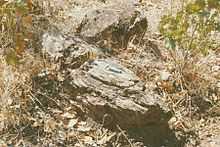Dadoxylon
| Dadoxylon | |
|---|---|
 | |
| Dadoxylon fossil trunks from the Bumi Hills area of Zimbabwe | |
| Scientific classification | |
| Kingdom: | Plantae |
| Division: | Pinophyta |
| Class: | Pinopsida |
| Order: | Pinales |
| Family: | Araucariaceae (?) |
| Genus: | †Dadoxylon Endlicher, 1847 |
Dadoxylon is a form genus of fossil wood, including massive tree trunks. Dadoxlyon is identified from the late Palaeozoic to the end of the Mesozoic,[1] but especially common in the Carboniferous.[2]
Description
Dadoxylon were large trees that bore long strap-like leaves and trunks with small, narrow rays.[2]
Distribution
Dadoxylon is common in many parts of the world, found in sites of both Gondwanaland and Laurasia and reported from southern Africa,[3] central Asia,[4] eastern Europe,[5] South America[6] and North America.[2]
In southern Africa, Dadoxylon is widespread in the Pebbly Arkose Formation[3] and also reported frequently from the Angwa Sandstone Formation.[7][8]
Systematics
Dadoxlyon may be the same form genus as Araucarioxylon, hence the usage Dadoxylon (Araucarioxylon).[9] Araucarioxylon is classified under family Araucariaceae.[10]
Several Dadoxylon species, such as D. brandlingii and D. saxonicum have been identified as Araucarites.[5]
References
- ↑ Giraud, Bernadette (1991). "Les espèces du genre Dadoxylon depuis 1962: Leur répartition et leur évolution du Permien à la fin du Mésozoïque". Review of Palaeobotany and Palynology 67: 13. doi:10.1016/0034-6667(91)90014-T.
- ↑ 2.0 2.1 2.2 Falcon-Lang, Howard J. (2011). "Fossil wood". Geology Today 27 (4): 154. doi:10.1111/j.1365-2451.2011.00803.x.
- ↑ 3.0 3.1 Nugent, Chris (1990). "The Zambezi River: Tectonism, climatic change and drainage evolution". Palaeogeography, Palaeoclimatology, Palaeoecology 78: 55. doi:10.1016/0031-0182(90)90204-K.
- ↑ Naugolnykh, S. V.; Ponomarenko, A. G. (2010). "Possible traces of feeding by beetles in coniferophyte wood from the Kazanian of the Kama River basin". Paleontological Journal 44 (4): 468. doi:10.1134/S0031030110040131.
- ↑ 5.0 5.1 Mencl, Václav; Matysová, Petra; Sakala, Jakub (2009). "Silicified wood from the Czech part of the Intra Sudetic Basin (Late Pennsylvanian, Bohemian Massif, Czech Republic): Systematics, silicification and palaeoenvironment". Neues Jahrbuch für Geologie und Paläontologie - Abhandlungen 252 (3): 269. doi:10.1127/0077-7749/2009/0252-0269.
- ↑ Francine Kurzawe and Sheila Merlotti. "O complexo Dadoxylon-Araucarioxylon, Carbonífero e Permiano do Gondwana: estudo taxonômico do gênero Dadoxylon". Pesquisas em Geociências 36: 223–232.
- ↑ P.M. Oesterlen (1990). "The geology of the Dande West area (western Cabora Bassa Basin) - a preliminary report". Annals of the Zimbabwe Geological Survey 14: 12–20.
- ↑ D. Love (1997). "The geology of the Chirundu area, Zambezi Valley". Annals of the Zimbabwe Geological Survey 18: 18–26.
- ↑ Philippe, Marc (2011). "How many species of Araucarioxylon?". Comptes Rendus Palevol 10 (2–3): 201. doi:10.1016/j.crpv.2010.10.010.
- ↑ Frank H. Knowlton (1889). "New species of fossil wood (Araucarioxylon arizonicum) from Arizona and New Mexico". Proceedings of the United States National Museum 11: 1–5.